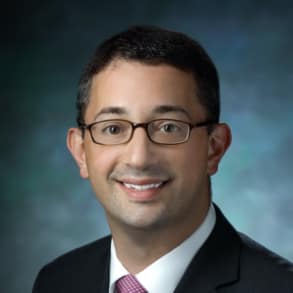Orthopaedic oncologist, Adam Levin, discusses the importance of personalized care plans and why they are key to successful clinical outcomes. These personalized plans, developed by a multidisciplinary team, help to identify patients at risk and implement mitigation strategies to improve outcomes and avoid unnecessary surgeries.
Hi, My name's Adam Levin and the Department of Orthopedic Oncology at Johns Hopkins University. You know, we know that a personalized care plan that suits each individual patient is the key to our clinical success. We partner closely with our colleagues across Johns Hopkins to advance patient care both for now and for the future. We know that patients with advanced disease from a number of malignancies may have, ah, high risk of developing bone metastases that these can put the patient at high risk for fracture. Take this gentleman, for example. He presented with some vague discomfort in his thigh in the setting of multiple myeloma. His radiographs demonstrated too few skeletal involvements. Note here that there's a number of areas of cortical thinning in the anterior cortex of the right femur. It appeared to place him at high risk for frac. However, we have noted that many of our myeloma patients with appropriate treatments we can mitigate that risk without operative operative treatment. In fact, when we look back at his images over four years earlier, we can see that these really haven't changed over the course of time. Perhaps he really isn't that as much of ah, high risk as we thought. So we started to look back at some of our own patients who presented with fractures, who did not. Who did we feel compelled to operate on? Who did we watch? In the end, we were able to stratify patients by risk factors developing a predictive scoring system specific to myeloma bone disease. We took this a few steps further, together with our brilliant residents and colleagues from radiology and civil engineering were able to develop a mechanical model using CT derived finite element analysis to predict the bone response. Our multidisciplinary efforts with radiation oncology, medical oncology toe, identify patients at risk and implement mitigation strategies have greatly improved our outcomes and our ability to avoid unnecessary surge. Our efforts in developing the musculoskeletal tumor registry as well as Dr Forsberg's work with the International Bone Metastases Registry will undoubtedly present opportunities for further understanding and advancements in the field. Ultimately, this work has really helped us understand which patients are optimally treated with prophylactic intervention. Larry Now which nails may need augmentation with PMO, may which patients are better suited for Arthur plastic and whether those should be long stone to short cemented or press fit and when a larger reconstruction may provide the best long term functional restoration. So sometimes we recognize that despite its appearance and barrel score, this large lyric lesion in the mid diagnosis is just not likely to fracture in this patient's lifetime, and this one be treated non operative, Thank you very much.



